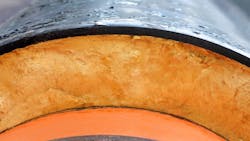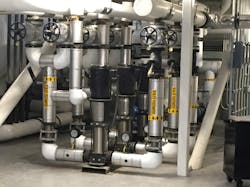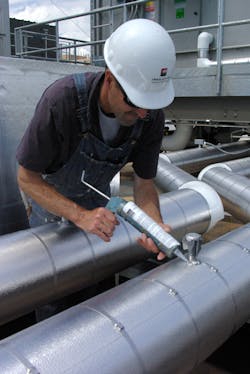What Owners Need to Know About ... Mechanical Insulation
In mechanical systems, insulation is required on pipes, ducts, tanks, and equipment. The insulation controls temperature variation to help limit heat gain or loss on surfaces operating above or below the ambient temperature.
Two types of mechanical systems require insulation: piping and HVAC.
Piping systems that carry water with an operating temperature of 105°F or more or 60°F or less need to be thermally insulated, according to both ANSI/ASHRAE/IES 90.1-2010, Energy Standard for Buildings Except Low-Rise Residential Buildings, and 2012 International Energy Conservation Code (IECC) Section C403.2.8. For pipe moving chilled water, ANSI/ASHRAE/IES 90.1-2010 requires a layer of vapor retardant without the use of adhesive tape on the outside of insulating material.
ANSI/ASHRAE/IES 90.1-2010 Section 64.4.1 requires HVAC-system insulation on chilled-water pipes, heating hot-water pipes, steam pipes, steam condensate pipe, ductwork, and the like.
Mechanical insulation comes in various combinations of materials. The materials commonly are rated by their performance in the areas of thermal conductivity, water-vapor resistance, thickness, and density. The choice for a project depends on the desired operating conditions.
Insulation Materials
With so many insulation options available, mechanical-system engineers are able to meet the precise needs of their applications. Common insulation types include fiberglass, mineral wool, rigid or flexible foam, polyethylene or other polyurethane-based materials, calcium silicate, cellular glass, and aerogel.
Thermal Resistance and Heat Loss
R-value is a measure of a material’s ability to prevent the transfer of heat, or, in other words, its ability to resist conduction, convection, and radiation. Conduction is the direct transfer of heat from one substance to another. Convection is the direct transfer of heat from a fluid, including air. Radiation is the transfer of heat through empty space. R is expressed as the thickness of a material normalized to the thermal conductivity. Higher R-values equate to better thermal performance and heat retention.
Increasing the thickness of an insulating layer increases the thermal resistance. To calculate the R-value of multilayered insulation, one must add the R-values of the individual layers. Manufacturer R-values are applicable only if insulation is installed properly.
According to Section C404.5 of the 2012 IECC, hot-water piping should be insulated with at least 1 in. of material with a conductivity not exceeding 0.27 Btu in./(h ft2 °F). The first 8 ft of piping in a non-hot-water-supply temperature-maintenance system served by equipment without integral heat traps should be insulated with 0.5 in. of material with a conductivity not exceeding 0.27 Btu in./(h ft2 °F).
Applications
Mechanical systems distribute hot or cold air throughout a building by means of pipe or ductwork. Proper insulation reduces energy costs and prevents condensation from forming on cold and chilled pipework. Pipe insulation used on water-supply pipework helps to delay pipe freezing.
The performance of pipe insulation can be influenced by many factors. Principal factors include thermal conductivity, surface emissivity, water-vapor resistance, insulation thickness, and density. Other factors, such as moisture content, can influence overall performance.
Thermal insulation is designed to prevent the transmission of heat from one side of the insulation to the other. Thermal insulation has several useful applications in terms of mechanical systems. The most common are:
- Condensation control. As is the case with any vessel full of liquid at below-ambient temperature, colder pipes often develop condensed water vapor on their exterior, an undesirable effect that can lead to corrosion and water damage. Certain types of pipe insulation developed for condensation control feature a barrier that keeps airborne water vapor separate from the surface of the pipe and prevents condensation from forming.
- Freeze prevention. Exterior pipes and pipes in below-freezing environments are at risk of internal freezing, which creates blockages. Water expands as it freezes, so a water pipe that freezes likely will rupture, shutting down the entire process. The goal of insulation is to keep the temperature of liquid inside of pipe at desired levels. Although insulation alone cannot keep pipe from freezing, it can increase the time it takes for pipe to freeze. With insulation and heat-trace cables on outdoor pipe, liquid has adequate time to get to its destination before the pipe becomes blocked.
- Energy efficiency. When pipes are operating at temperatures significantly above or below ambient temperature, a transfer of heat occurs as the liquid inside the pipe adjusts to the temperature of the surrounding air. This means the energy exerted to achieve a certain temperature of the liquid within the pipe will be wasted. The energy it takes to restore the pipe to its correct operating temperature is an added utility expense that could be avoided with proper insulation on the exterior of the pipe.
- Safety. Pipe can operate at temperatures that make it unsafe to touch, while ductwork can have sharp edges that pose a safety risk. Properly selected and installed insulation is useful in preventing injuries.
Maintenance
Installed properly, mechanical insulation can last for years. Eventually, though, whether from gradual wear and tear or environmental changes, it can deteriorate, leading to increased energy use, temperature loss, and leakage.
Regular inspection and maintenance is best performed by a professional mechanical-insulation contractor. Periodic examination and assessment of the general state of insulation allows areas of concern to be identified.
If deterioration is detected, mechanical insulation will require replacement. Mechanical insulation that withstands changes from one temperature extreme to another is especially likely to require full or partial replacement.
Conclusion
Made from a variety of materials that achieve slightly different results, mechanical insulation is installed primarily to create a barrier between the contents of a pipe or duct and the environment outside. Improperly insulated mechanical systems can lead to decreased efficiency, increased condensation, unwanted freezing, and even harm to people who come in contact with them.
It is imperative not only that the right mechanical insulation for a project be selected, but that it be properly installed, routinely inspected, correctly maintained, and, at the appropriate time, replaced.
John Buffa is a sales engineer for ISS Insulation Services & Solutions, a full-service insulation contractor specializing in commercial and industrial projects and a member of the National Insulation Association. He can be contacted at [email protected].
Did you find this article useful? Send comments and suggestions to Executive Editor Scott Arnold at [email protected].



